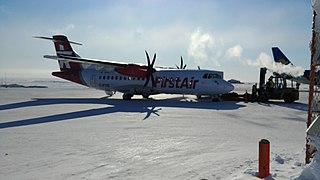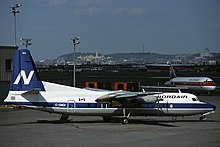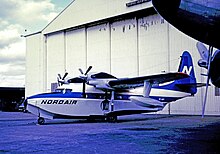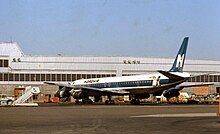
Montréal–Trudeau International Airport or Montréal–Trudeau, formerly known and still commonly referred to as Montréal–Dorval International Airport, is an international airport in Dorval, Quebec, Canada. It is the only Transport Canada designated international airport serving Montreal and is situated 20 km (12 mi) west of Downtown Montreal. The airport terminals are located entirely in the suburb of Dorval, while one runway is located in the Montreal borough of Saint-Laurent. Air Canada, the country's flag carrier, also has its corporate headquarters complex on the Saint-Laurent side of the airport. It also serves Greater Montreal and adjacent regions in Quebec and eastern Ontario, as well as the states of Vermont and northern New York in the United States. The airport is named in honour of Pierre Elliott Trudeau, the 15th Prime Minister of Canada and father of current Prime Minister Justin Trudeau.
Canadian Airlines International Ltd. was a major Canadian airline that operated from 1987 until 2001. The airline was Canada's second largest airline after Air Canada, carrying more than 11.9 million passengers to over 160 destinations in 17 countries on five continents at its height in 1996. Canadian Airlines served 105 destinations in Canada, more than any other airline. It was a founding member of the Oneworld airline alliance.

Bradley Air Services Limited, operating as First Air, was an airline headquartered in Kanata, a suburb of Ottawa, Ontario, Canada. It operated services to 34 communities in Nunavut, Nunavik, and the Northwest Territories. First Air has assisted in various humanitarian missions such as the 2010 Haiti earthquake, airlifting relief supplies and equipment. Its main base, which included a large hangar, cargo and maintenance facility, was located at Ottawa Macdonald–Cartier International Airport, with hubs at Iqaluit Airport, and Yellowknife Airport. On November 1, 2019, the airline consolidated operations with Canadian North.

Thunder Bay Airport is in the city of Thunder Bay, Ontario, Canada. With 108,130 aircraft movements in 2012, it was the fourth busiest airport in Ontario and the 16th busiest airport in Canada. During the same year, more than 761,000 passengers went through the airport.

Eastern Provincial Airways (EPA) was an airline that operated in Atlantic and eastern Canada. At its peak, the carrier operated jet service with Boeing 737-200 aircraft connecting many communities that in the first quarter of the 21st century only have scheduled passenger flights provided by 18-seat commuter turboprop aircraft. The airline traces its history from Maritime Central Airways (MCA) from 1961. It merged with CP Air to form Canadian Pacific Air Lines in 1986.
Air Ontario Inc. was a Canadian regional airline with its predecessor initially headquartered in Sarnia and later in London, Ontario. In 2002, Air Ontario became Air Canada Jazz.

Austin Airways was a passenger airline and freight carrier based in Timmins, Ontario, and one of the oldest in Canada.

Bradley Air Services, operating as Canadian North, is a wholly Inuit-owned airline headquartered in Kanata, Ontario, Canada. It operates scheduled passenger services to communities in the Northwest Territories, Nunavut, and the Nunavik region of Quebec, as well as southern destinations such as Edmonton, Montreal and Ottawa. It also has an interlining agreement with Air Greenland.

Les Investissements Nolinor Inc., trading as Nolinor Aviation, is a charter airline based in Mirabel, a suburb of Montreal, Quebec, Canada. It operates passenger charter and cargo services within Canada and to the United States. Its main base is Montréal–Mirabel International Airport. It has 200 employees.

Combi aircraft in commercial aviation are aircraft that can be used to carry either passengers as an airliner, or cargo as a freighter, and may have a partition in the aircraft cabin to allow both uses at the same time in a mixed passenger/freight combination. The name combi comes from the word combination. The concept originated in railroading with the combine car, a passenger car that contains a separate compartment for mail or baggage.

Iqaluit Airport serves Iqaluit, Nunavut, Canada and is located adjacent to the city. It hosts scheduled passenger service from Ottawa, Montreal, Rankin Inlet, and Kuujjuaq on carriers such as Canadian North, and from smaller communities throughout eastern Nunavut. It is also used as a forward operating base by the Royal Canadian Air Force (RCAF). In 2011, the terminal handled more than 120,000 passengers.

Resolute Bay Airport is located at Resolute, Nunavut, Canada, and is operated by the government of Nunavut. It is the second northernmost aerodrome in Canada to receive scheduled passenger airline service; Grise Fiord Airport, which is served from Resolute, is further north. Alert Airport, the northernmost airport in Canada and the world, Tanquary Fiord Airport, and Eureka Aerodrome are all further north but have no scheduled services. Alert and Eureka are both served by Resolute.
Quebecair was a Canadian airline that operated from 1947 until 1986. Quebecair was headquartered in Saint-Laurent, Quebec, now a part of Montreal.
Churchill Falls Airport is owned and operated by Churchill Falls Labrador Corporation Limited. Provincial Airlines provides regularly scheduled passenger service at the airport, which handled about 1,400 passengers annually over between 2000 and 2003. The airport is located 4 nautical miles northwest of Churchill Falls, Newfoundland and Labrador, Canada.
Dolbeau-Saint-Félicien AirportAéroport Dolbeau-St-Félicien, is located 8.5 nautical miles southwest of Dolbeau-Mistassini, Quebec, Canada.

Kuujjuaq Airport is an airport located 1.5 nautical miles southwest of Kuujjuaq, Quebec, Canada.

CFFB is a Canadian radio station, broadcasting at 1230 AM. It operates a nested FM rebroadcasting transmitter, CFFB-FM-3 at 91.1 MHz in Iqaluit, Nunavut. The station broadcasts the programming of the CBC Radio One network, and serves as the regional network centre for Nunavut for the CBC North service.

Starlink Aviation is a Canadian charter airline and a fixed-base operator. It is based at the Montréal–Trudeau International Airport in Dorval, Quebec.
Intair was a Canada-based airline that operated between 1989 and 1991.

La Grande Rivière Airport is an airfield location about 30 km (19 mi) south southwest of Radisson, Quebec, Canada. It is used mostly to shuttle Hydro-Québec personnel between Radisson and the larger cities in Quebec, but it is also served by regular scheduled flights of Air Inuit. Passengers from Nunavik region flying south to Montreal go through security at this airport instead of their origin airport.





















